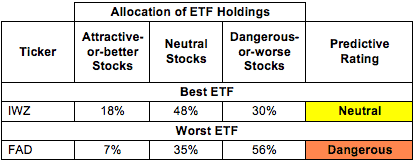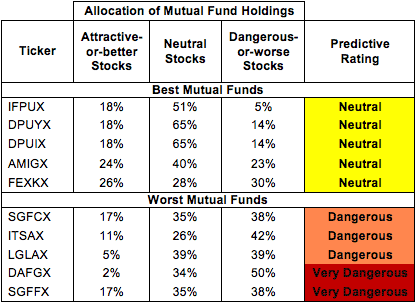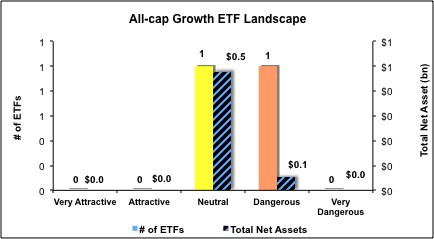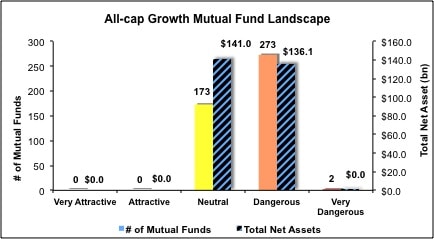The All Cap Growth style ranks fifth out of the twelve fund styles as detailed in my Style Rankings for ETFs and Mutual Funds report. It gets my Neutral rating, which is based on aggregation of ratings of 2 ETFs and 448 mutual funds in the All Cap Growth style as of January 28, 2014. Prior reports on the best & worst ETFs and mutual funds in every sector and style are here.
Figure 1 ranks from best to worst the two all-cap growth ETFs and Figure 2 shows the five best and worst-rated all-cap growth mutual funds. Not all All Cap Growth style ETFs and mutual funds are created the same. The number of holdings varies widely (from 17 to 2059). This variation creates drastically different investment implications and, therefore, ratings. The best ETFs and mutual funds allocate more value to Attractive-or-better-rated stocks than the worst, which allocate too much value to Neutral-or-worse-rated stocks.
To identify the best and avoid the worst ETFs and mutual funds within the All Cap Growth style, investors need a predictive rating based on (1) stocks ratings of the holdings and (2) the all-in expenses of each ETF and mutual fund. Investors need not rely on backward-looking ratings. My fund rating methodology is detailed here.
Investors should not buy any All Cap Growth ETFs or mutual funds because none get an Attractive-or-better rating. If you must have exposure to this style, you should buy a basket of Attractive-or-better rated stocks and avoid paying undeserved fund fees. Active management has a long history of not paying off. Here’s the list of our top-rated All Cap Growth stocks.
Get my ratings on all ETFs and mutual funds in this style by searching for All Cap Growth on my free mutual fund and ETF screener.
Figure 1: ETFs with the Best & Worst Ratings

Sources: New Constructs, LLC and company filings
Figure 2: Mutual Funds with the Best & Worst Ratings – Top 5

Sources: New Constructs, LLC and company filings
Six mutual funds are excluded from Figure 2 because their total net assets (TNA) are below $100 million and do not meet our liquidity minimums.
iShares Russell 3000 Growth ETF (IWZ) is my top-rated All Cap Growth ETF and Advisors Investment Trust Independent Franchise Partners U.S. Equity Fund (IFPUX) is my top-rated All Cap Growth mutual fund. Both earn my Neutral rating.
First Trust Multi Cap Growth AlphaDEX Fund (FAD) is my worst-rated All Cap Growth ETF and Sparrow Growth Fund (SGFFX) is my worst-rated All Cap Growth mutual fund. FAD earns my Dangerous rating, while SGFFX gets my Very Dangerous rating.
Figure 3 shows that 220 out of the 2144 stocks (over 14% of the market value) in All Cap Growth ETFs and mutual funds get an Attractive-or-better rating. However, neither of the two All Cap Growth ETFs and zero out of 448 All Cap Growth mutual funds get an Attractive-or-better rating.
The takeaways are: mutual fund managers allocate too much capital to low-quality stocks and All Cap Growth ETFs hold poor quality stocks.
Figure 3: All Cap Growth Style Landscape For ETFs, Mutual Funds & Stocks

As detailed in “Low-Cost Funds Dupe Investors”, the fund industry offers many cheap funds but very few funds with high-quality stocks, or with what I call good portfolio management.
Investors need to tread carefully when considering All Cap Growth ETFs and mutual funds, as most earn Dangerous or below ratings. No ETFs or mutual funds in the All Cap Growth style allocate enough value to Attractive-or-better-rated stocks to earn an Attractive rating. Investors would be better off focusing on individual stocks instead.
Kroger (KR) is one of my favorite stocks held by All Cap Growth ETFs and mutual funds and earns my Attractive rating. Kroger has grown profits (NOPAT) by 8% compounded annually since 1998 and has a return on invested capital (ROIC) of 7%. KR has also grown economic earnings by 35% compounded annually since 2008. Despite Kroger’s history of consistent profit growth, its stock remains undervalued. The company’s current share price of ~$36/share gives KR a price to economic book value (PEBV) ratio of 0.8. This number implies that the market expects KR’s profits to permanently decline by 20%. Kroger’s consistent profit and revenue growth, as well as its recent acquisition of competitor Harris Teeter, makes this future decline look unlikely. Kroger shares are currently a bargain and investors would be wise to look carefully at this well-managed company.
Citigroup (C) is one of my least favorite stocks held by All Cap Growth ETFs and mutual funds and earns my Dangerous rating. Citi’s profits (NOPAT) have declined by 4% compounded annually since 2000, and its NOPAT margins have dropped sharply over that time from 22% to 14%. Citi’s free cash flow yield sits at under 1% and its return on invested capital (ROIC) is just 3%, which puts it in the bottom quintile of all companies I cover. Also discouraging is the fact that Citi has never earned positive economic earnings going back to 1998. It is the only Big Four financial institution with this distinction. Despite this consistent underperformance over the past 14 years, Citi currently trades at an overvalued ~$49/share. To justify this stock price, Citi would need to grow profits by 10% compounded annually for the next 9 years. Given the current uncertain financial regulatory environment and past profit decline, this sudden growth seems unlikely. Investors should avoid this stock as long as it trades this high and profit growth remains as low as it has been.
Figures 4 and 5 show the rating landscape of all All Cap Growth ETFs and mutual funds.
My Style Rankings for ETFs and Mutual Funds report ranks all styles and highlights those that offer the best investments.
Figure 4: Separating the Best ETFs From the Worst Funds

Figure 5: Separating the Best Mutual Funds From the Worst Funds
Review my full list of ratings and rankings along with reports on all 2 ETFs and 448 mutual funds in the All Cap Growth style.
Andre Rouillard contributed to this report.
Disclosure: David Trainer and Andre Rouillard receive no compensation to write about any specific stock, sector, style or theme.

